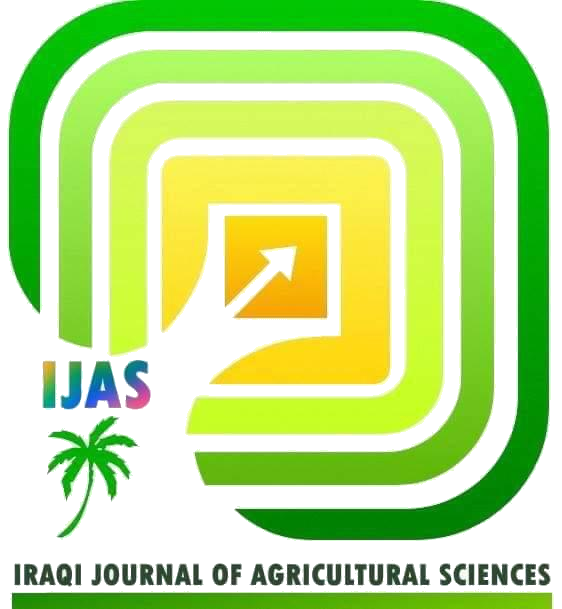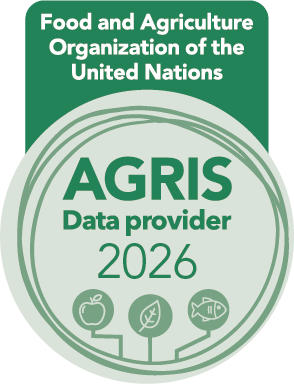IMMUNOLOGICAL STATUS OF SALMONELLA PULLORUM-INFECTED BROILERS TREATED WITH BACILLUS SUBTILIS, ORGANIC ACIDS AND CIPROFLOXACIN
DOI:
https://doi.org/10.36103/d6901b37Keywords:
ELISA, IgG, IFN-γ, MPN, growth efficiency, challenged, acidifier.Abstract
The current study was aimed to ascertain the impact of ciprofloxacin, an acidifier acid, and a Bacillus subtilis on immunological function and growth efficiency after a starter-phase challenge with Salmonella pullorum. 250 broiler chicks (Ross 308) were put into five groups of fifty each, all groups except the fifth group, orally challenged with S. pullorum at one day old, and provided with a supplement in drinking water after three days as follow G1: treated with B. subtilis (2×107 CFU/g) (250 g/1000 L). G2: treated with acidifier acid (0.5-1 ml/L). G3: treated with ciprofloxacin 10% (0.5 ml/L). G4: only infected with S. pullorum. G5: control negative. The findings revealed extremely significant variations in the means antibodies (IgG) and IFN-γ titre against Salmonella pullorum in serum which was increased significantly at the level (P≤0.05) in all groups at 7 days, particularly in G4 and G1, in comparison with G5, but, at 21 and 35 days the results of IgG and IFN-γ titers showed a significant decrease (P>0.05), the results of immunity matching with most probable number (MPN/g) of S. pullorum in feces. Additionally, the highest significantly differences at the level (P≤0.05) in growth performance across all groups. We conclusion, the organic acid has biggest role in protection in comparison with ciprofloxacin that have immunosuppression also, the B. subtilis not recorded any protection.
References
1. Abudabos, A.M., M.H. Ali, M.A. Nassan and A.A. Saleh. 2019. Ameliorative effect of Bacillus subtilis on growth performance and intestinal architecture in broiler infected with Salmonella. Animals. 9(4): 190-198.
2. Al-Zuhariy, M. T. 2022. Using T cell lymphokines of hyperimmunized chickens with Salmonella pullorum to protect layer hens against Salmonella pullorum infection. Iraqi Journal of Veterinary Sciences. 36(1):223-227.
3. Al-Zuhariy, M. T. 2022. Using T cell lymphokines of hyperimmunized chickens with Salmonella pullorum to enhance immune response of layer hens against avian influenza. The Iraqi Journal of Veterinary Sciences. 36(1): 229-234.
4. Anderson, L. A., D. A. Miller, and D. W. Trampel, 2006. Epidemiological investigation, cleanup, and eradication of pullorum disease in adult chickens and ducks in two small-farm flocks. Avian diseases, 50(1), 142-147. https://doi.org/10.1637/7397-062105R.1
5. Brunett, E. L. 1930. Pullorum disease in the mature turkey. Poultry Science, 9(6), 356-360. https://doi.org/10.3382/ps.0090356
6. Barrow, P. A., and O. F. Neto, 2011. Pullorum disease and fowl typhoid—new thoughts on old diseases: a review. Avian Pathology, 40(1), 1-13. https://doi.org/10.1080/03079457.2010.542575
7. Brunner, H. and H. J. Zeiler. 1988. Oral ciprofloxacin treatment for Salmonella typhimurium infection of normal and immunocompromised mice. Antimicrobial Agents and Chemotherapy. 32(1):57-62.
8. Calenge, F., P. Kaiser, A. Vignal and C. Beaumont. 2010. Genetic control of resistance to salmonellosis and to Salmonella carrier-state in fowl: a review. Genetics Selection Evolution. 42(1):1-11.
9. Chen, K., N. Dong, E.W.C. Chan and S. Chen. 2019. Transmission of ciprofloxacin resistance in Salmonella mediated by a novel type of conjugative helper plasmids. Emerging Microbes and Infections. 8(1):857-865.
10. Couper, K.N., D.G. Blount and E.M. Riley. 2008. IL-10: the master regulator of immunity to infection. The Journal of Immunology. 180(9): 5771-5777.
11. Davis, R., A. Markham and J.A. Balfour. 1996. Ciprofloxacin: an updated review of its pharmacology, therapeutic efficacy and tolerability. Drugs. 51(6):1019-1074.
12. Dersjant-Li, Y., K. Gibbs, A. Awati and K.C. Klasing. 2016. The effects of enzymes and direct fed microbial combination on performance and immune response of broilers under a coccidia challenge. Journal of Applied Animal Nutrition. 4(22):1-6.
13. Evans, N.P., D.A. Collins, F.W. Pierson, H.M. Mahsoub, N. Sriranganathan, M.E. Persia, T.P. Karnezos, M.D. Sims and R.A. Dalloul. 2017. Investigation of medium chain fatty acid feed supplementation for reducing Salmonella typhimurium colonization in turkey poults. Foodborne Pathogens and Disease. 14(9):531-536.
14. Gong, J., F. Yin, Y. Hou and Y. Yin. 2014. Chinese herbs as alternatives to antibiotics in feed for swine and poultry production: potential and challenges in application. Canadian Journal of Animal Science. 94(2): 223-241.
15. Hayat, T., A. Sultan, R.U. Khan, S. Khan, R. Ullah and T. Aziz. 2014. Impact of organic acid on some liver and kidney function tests in Japanese quails, Coturnix coturnix japonica. Pakistan Journal of Zoology. 46(4):223-237.
16. He, H., K.M. MacKinnon, K.J. Genovese, J.R. Nerren, C.L. Swaggerty, D.J. Nisbet and M.H. Kogut. 2009. Chicken scavenger receptors and their ligand-induced cellular immune responses. Molecular Immunology. 46(11-12): 2218-2225.
17. Kubasova, T., M. Kollarcikova, M. Crhanova, D. Karasova, D. Cejkova, A. Sebkova, J. Matiasovicova, M. Faldynova, A. Pokorna, A. Cizek and I. Rychlik. 2019. Contact with adult hen affects development of caecal microbiota in newly hatched chicks. PLoS One. 14(3):0212446.
18. Kumar, V.S., G.S. Chandra, J. Ramesh, S. Vairamuthu, P. Thejomoorthy and P. Hariharan. 2012. Effect of enrofloxacin administration on haematological profile in broiler chicken-A safety pharmacology study. Indian Journal of Veterinary Sciences and Biotechnology. Dec 8(2):20-4.
19. Lee, K.W., D.K. Kim, H.S. Lillehoj, S.I. Jang and S.H. Lee. 2015. Immune modulation by Bacillus subtilis-based direct-fed microbials in commercial broiler chickens. Animal Feed Science and Technology. 41(200):76-85.
20. Mohammed, R.A. and M.T. AL-Zuhariy. 2018. Protection of neonatal broiler by using T cell lymphokines prepared from immunization with Salmonella typhimurium against field local Newcastle disease virus isolate. International Journal of Poultry Science. 17(8): 367-373.
21. Matos, M., F. Sommer, D. Liebhart, I. Bilic, M. Hess, and C. Hess, 2021. An outbreak of Pullorum disease in a young layer parent flock in Austria presented with central nervous system signs. Avian diseases, 65(1), 159-164. . https://doi.org/10.1637/aviandiseases-D-20-00091
22. Qatan, G.A. 2008. Preparing of saccharomyces Cereviciae Synbiotic for reducing experimental infection of Salmonella typhimurium in broiler 2–advanced age (16-30 days). The Iraqi Journal of Veterinary Medicine. 32(1): 47-58.
23. Saleh, B. H., H. N. Yahya and R. N. Ibrahim. 2023. Study antibacterial activity of laurus nobilis leaves water extract on some isolates of pathogenic bacteria. Iraqi Journal of Agricultural Sciences. 54(1): 18-24. https://doi.org/10.36103/ijas.v54i1.1672
24. Sultan, A., T. Ullah, S. Khan and R.U. Khan. 2015. Effect of organic acid supplementation on the performance and ileal microflora of broiler during finishing period. Pakistan Journal of Zoology. 47(3):24-31.
25. Tarradas, J., N. Tous, E. Esteve-Garcia and J. Brufau. 2020. The control of intestinal inflammation: A major objective in the research of probiotic strains as alternatives to antibiotic growth promoters in poultry. Microorganisms. 8(2):148-156.
26. Tokarzewski, S. 2002. Influence of enrofloxacin and chloramphenicol on the level of IgY in serum and egg yolk after immunostimulation of hens with Salmonella enteritidis antigens. Polish Journal of Veterinary Sciences. 5(3): 151-158.
27. Varmuzova, K., T. Kubasova, L. Davidova-Gerzova, F. Sisak, H. Havlickova, A. Sebkova, M. Faldynova and I. Rychlik. 2016. Composition of gut microbiota
influences resistance of newly hatched chickens to Salmonella Enteritidis infection. Frontiers in microbiology. 7(33): 957-966.
28. Williams, A.C., H.F. Galley, A.M. Watt and N.R. Webster. 2005. Differential effects of three antibiotics on T helper cell cytokine expression. Journal of Antimicrobial Chemotherapy. 56(3):502-506.
29. Yang, J., K. Qian, C. Wang and Y. Wu. 2018. Roles of probiotic lactobacilli inclusion in helping piglets establish healthy intestinal inter-environment for pathogen defense. Probiotics and Antimicrobial Proteins. 10(21):243-250.
30. Yang, Z. and S.F. Liao. 2019. Physiological effects of dietary amino acids on gut health and functions of swine. Frontiers in Veterinary Science. 6(43):169-177.
31. Yasmin, S., M. Nawaz, A.A. Anjum, K. Ashraf, M.A.R. Basra, A. Mehmood, I. Khan and F. Malik. 2020. Phytochemical analysis and In Vitro activity of essential oils of selected plants against Salmonella enteritidis and Salmonella gallinarum of poultry origin. Pakistan Veterinarian Journal. 40(02):139-144.
32. Zhou, X., X. Kang, K. Zhou and M. Yue. 2022. A global dataset for prevalence of Salmonella gallinarum between 1945 and 2021. Scientific Data. 9(1):495-501.
Downloads
Published
Issue
Section
License
Copyright (c) 2025 IRAQI JOURNAL OF AGRICULTURAL SCIENCES

This work is licensed under a Creative Commons Attribution-NonCommercial 4.0 International License.

2.jpg)


